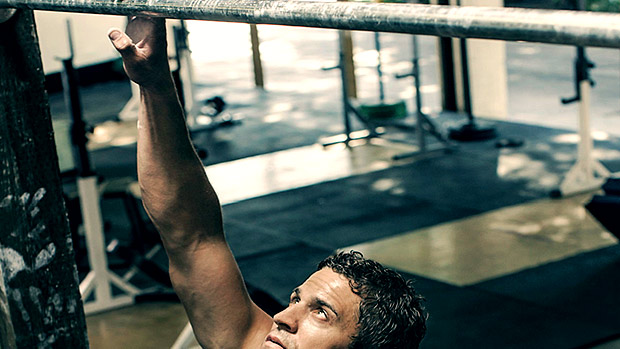A perfect chin-up (supinated grip – palms facing you) is a rare sight in the gym. During a properly executed chin-up, the core should be engaged as you use your lats and biceps to pull your chin up and over the bar.
Where It All Goes Wrong
There are two reasons why a lot of people fail at this:
- Many people just don't have the strength to hit a proper chin-up, or at least they don't have enough strength for their bodyweight.
- They rely too much on the biceps and don't understand the technique behind the chin-up.
The Solutions
1 – Get Stronger
Chin-ups are hard. Although the goal should be to improve upon weaknesses in the gym, many people skip this exercise and go for the lat pulldown or bicep curl instead. But the only way to get good at something is to consistently practice.
Do some variation of the chin-up three times per week. If you're struggling to get one solid rep right now, try one of these strategies to get you started:
The Banded Chin-Up
The elastic band makes it easier at the bottom part of the movement, giving you a little spring to get yourself started. If you're a long ways off from doing a chin-up, start with a thick elastic band for more assistance and move down to a thinner band for less assistance as you progress. Also, make sure you're going "down and through" during the descent. More on this technique later.
The Eccentric (Negative) Chin-Up
Create time under tension by emphasizing the eccentric contraction – the lowering part of the chin-up. To perform this movement, give yourself some help by jumping to the top of the chin-up. Next, slowly lower yourself down to the bottom. The lowering portion should take two to three seconds.
Keep your core tight the entire time. A common way to cheat this is by holding for longer at the top, then lowering down quickly. Make sure you're not speeding through any part of the lowering phase. The hardest parts of the descent will trigger the most progress!
2 – Stop Relying on Your Biceps
This is a technique issue. When people can only do a few chin-ups, despite being obviously strong, it's generally because they rely too heavily on their biceps and underutilize their lats and core during the movement. How can you tell? They start swinging back and forth after a few reps.
Here's what this problem looks like:
When you do chin-ups you should think "down and through." This means you don't lower straight down from the top of the bar – your body actually comes between your arms.
This allows you to load the lats and stretch them so they can optimally contract. Once you're in this position, you can engage your core better by pulling your ribcage down as you begin your chin-up.
To practice this down-and-through method, find a spot on the floor in front of your chin-up bar and begin your chin-up with your feet slightly in front of the bar. (If using a high bar, aim for a bench.) Come into full extension before beginning your chin-up. Once you reach the top of the chin-up, lower down and through the arms so your feet come to the exact same spot you started from.
Once you understand how to come through the arms to load the lats, chin-ups become much easier. Be sure to keep your core engaged the entire time so you don't start swinging and get out of position.





